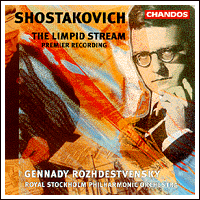
SHOSTAKOVICH
The Limpid Stream, Opus 39 (1935)
Royal Stockholm
Philharmonic Orchestra
cond. Gennady Rozhdestvensky
Chandos CHAN 9423
[68:31/DDD]

SHOSTAKOVICH
The Limpid Stream, Opus 39 (1935)
Royal Stockholm
Philharmonic Orchestra
cond. Gennady Rozhdestvensky
Chandos CHAN 9423
[68:31/DDD]
Rozhdestvensky's final volume in his series of Shostakovich's ballet scores features the legendary work which, along with the opera Lady Macbeth, was officially castigated in Pravda in January 1936, leading to Shostakovich's "unpersoning" and relegation to the background of the Soviet music scene. This demotion, which occurred at the height of Stalin's Terror, was no laughing matter and the composer's return to official favour with his Fifth Symphony occurred in spite of the attitude of Stalin's apparat, which remained hostile.
Shostakovich's brief in The Limpid Stream was to produce a score suitable for a scenario of almost parodistic naivety set in the Kuban wheat-fields. Whether the librettist Adrian Piotrovsky - author of the TRAM play Rule, Britannia! for which Shostakovich wrote incidental music in 1931 - harboured any tongue-in-cheek intent with his conflictless Socialist Realist plot is unknown. (He was purged and executed in 1938.) On the other hand, we may certainly infer irony on the part of Shostakovich, who "wrote" an article in 1935 apologising to proletarian critics for the regrettable lack of solemnity in his previous ballets and acknowledging that "the portrayal of socialist reality in ballet is a very serious business" - before composing a score of pure candyfloss tinted with his usual facetious tonal derangements.
Shostakovich probably had a little fun with parts of The Limpid Stream and its success with Leningrad audiences during 1935 may have persuaded him that, despite his failure to fulfill his vow to keep a straight face on this occasion, he had managed to strike something approximating an acceptable note. Not that he had tried terribly hard. The full-length score contains many repetitions and some bolstering material imported from The Golden Age and The Bolt, while much of the rest is lightweight to the point of non-existence. Rozhdestvensky solves this by dropping the duplicated music, cutting 44 numbers to 29. (These divisions bear no relation to those given by Derek Hulme in his Shostakovich catalogue.) The result is a 70-minute score.
Several of the movements here - notably the Waltz - will already be known to those familiar with the Ballet Suites 1-3. As for the rest there are few real surprises, but probably enough from which to fashion a tolerable suite. One inclusion would have to be Rozhdestvensky's No. 12 (Hulme's No. 7), a scene portraying the end of work in the fields which, far from joyous, rises to a menacing fortissimo climax via a startlingly aggressive passage over pounding drums which anticipates a section of the first movement of the Twelfth Symphony. Also of interest is the grotesque satirical portrayal of two elderly summer residents (bassoon and contrabassoon) in Rozhdestvensky's No. 33 (Hulme's No. 15). This is the passacaglia theme recycled for full orchestra in the grim Introduction to Ballet Suite No. 4 (1953). (See Järvi's recording, coupled with the Tenth Symphony, Chandos CHAN 8630.) What, one wonders, is the story behind this tantalising transformation - and when did it take place: in the 1930s or the early 1950s?
Most of The Limpid Stream is functional stuff of the sort Shostakovich could turn out in his sleep. Conceivably it closely matched Fyodor Lopukhov's choreography. If so, it will be a pity if it turns out that this choreography is lost, since the way Shostakovich used sound to counterpoint visual events ought to be of interest to certain ponderous American academics of my acquaintance. Is this disc worth buying? Only if you're a fan who must have everything. But for a few exceptions, the music is feeble and, while well recorded, the performance is sometimes less than sufficiently sparkling.